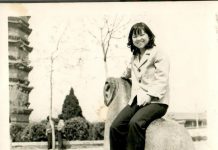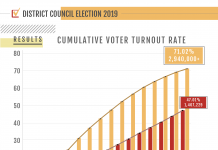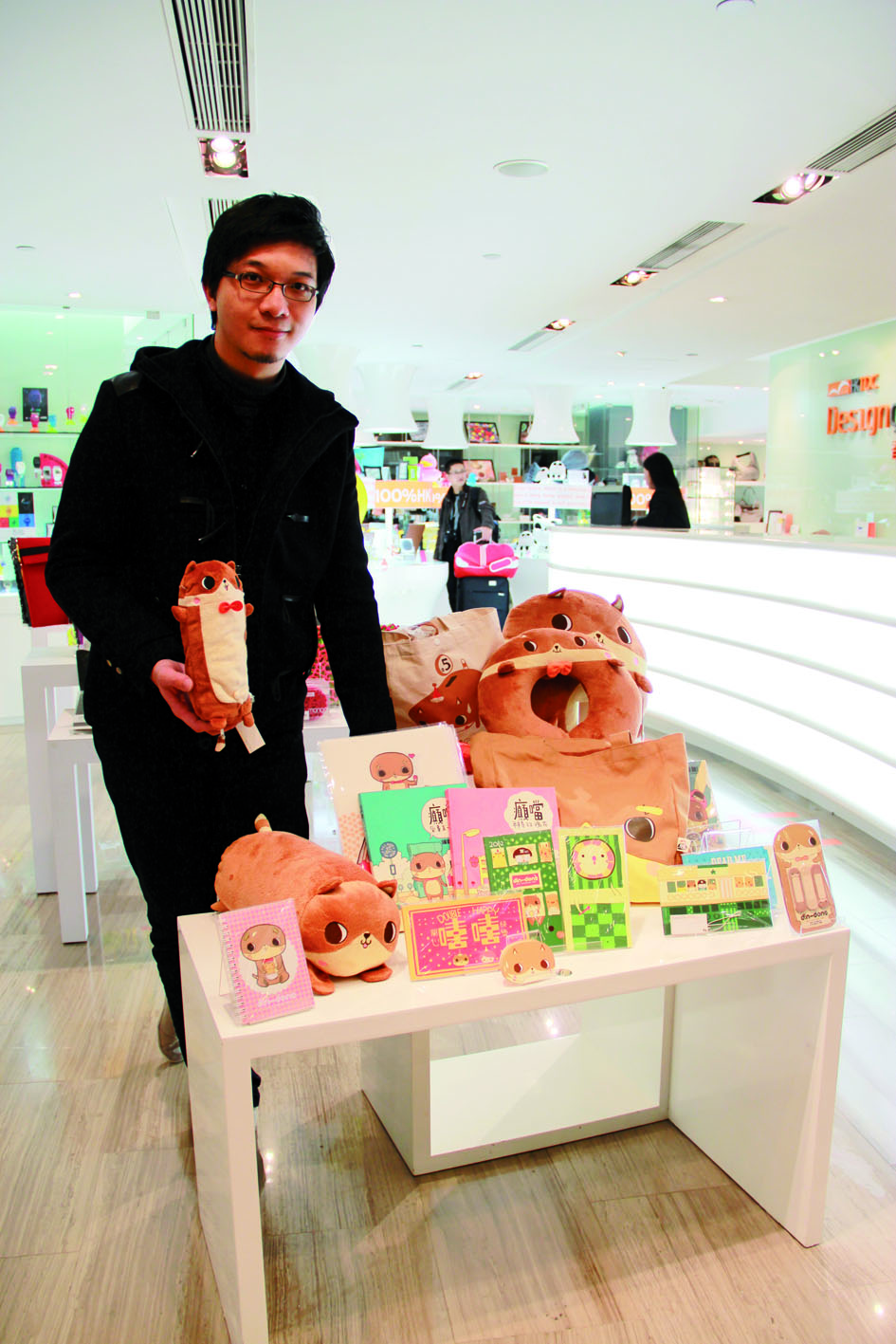John Chan Yu-fung creates tales to warm Hong Kong hearts
Reporter: Vivian Ng
A slim, bespectacled young man carefully arranges a display featuring soft toys and other products based on cartoon characters at the Design Gallery at the Hong Kong Convention and Exhibition Centre. What shoppers do not know is the man is actually an acclaimed animator and the creator of the Din-Dong character that the products are based on.
The attention to detail which he shows in arranging the products for a photo-shoot provide a clue to his training as an illustrator.
John Chan Yu-fung has won numerous local animation awards and is the first Chinese to win the grand prize in the TBS DigiCon6 Awards. But the 34-year-old prefers to call himself a “storyteller” rather than an animator.
Chan’s twin passions for storytelling and animation were planted in childhood when his parents took him to the cinema to watch an animated feature film, Laputa: Castle in the Sky.
The film, by prominent Japanese animator Hayao Miyazaki, tells the story of a boy who helps a girl with a flying gem from Laputa, a castle in the sky, to save the world.
Chan was hooked. “I realised that the scenes in a cartoon could also touch some of the audience members,” says Chan. “Then I started to think if I could do something similar in the future.”
After that, Chan’s enthusiasm for drawing blossomed. He excitedly recalls how he drew different cartoon characters in his primary school textbooks. This interest in drawing continued into his teenage years.
Chan learnt the basic skills of drawing in secondary school and continued to sketch but these skills did not help in his ambition to be a storyteller.
The turning point arrived when Chan’s secondary school art teacher told him a story about a colour-blind artist. The teacher inspired Chan by telling him how the artist used colours differently because of his disability, but created artworks with a strong personality.
The story gave Chan an insight into the process of creation. It helped him to think creatively and independently. “Those of us engaged in creation, we sometimes need to use things outside the normal confines, we have to use things other people haven’t thought of before,” Chan says.
After graduation, Chan worked as an illustrator at a company where he drew very detailed sketches. However, he soon left this job and, persuaded by a friend, he travelled to Australia in 1995.
Chan spent two years Down Under, taking drawing and language courses and travelling around the country. However, he learned most from his daily experience of life in Australia rather than the classes.
Chan found mixing with other international students an interesting experience. “You could see everyone had a distinct personality!” he says.
He particularly appreciated the humility the Japanese students showed towards learning. At the time, Chan had sometimes thought he was superior to others as a Hongkonger. He soon realised he was wrong.
“I discovered that if I continued with such an attitude, I would never learn anything,” says Chan. “But the Japanese could because they were humble enough to learn.”
Chan found the trip to Australia enlightening. He thinks it is easy to become numb if you just stay in the same place all the time. He points out: “Sometimes we can go to another place to observe the way people live there. You will have a very different experience and think much more broadly.”
In Australia, Chan visited many museums, art galleries and art exhibitions held in shopping malls. He was deeply impressed by the Australians’ respect for art and their effort to incorporate art into everyday life.
His time in the country bolstered Chan’s confidence in creating animations. He was reminded that art can move people, just as he had believed in childhood.
After coming back to Hong Kong, Chan changed his drawing style. He gave up drawing intricate sketches.
“Drawing these [very delicate drawings] is of little significance,” says Chan. “Focusing on the story or the message conveyed in the creation is more important than simply drawing something detailed.”
He did not become a full-time animator straight away. Instead, Chan worked as a multimedia designer, designing websites and software for teaching materials. Nevertheless, the job still gave him the opportunity to learn many techniques for creating animations as they were commonly included in websites. He also read books to further enrich his knowledge of technical animation skills.
Every day, Chan would spend a couple of hours after work to make his own animation. It could take up to several hours for him to complete several seconds of the animation as he needed to draw 25 frames for each second of the production.
In this way, he completed his first prize-winning animation, Foollee.
Foollee won the silver award in the ninth Hong Kong Independent Film Video Festival – Animation Category. It is a love story in which Foollee always secretly helps a girl and she finally finds out.
Chan hopes to convey the message that people should do things that make them feel good, even if other people mock them for it.
More and more advertising agencies came knocking on Chan’s door after the prize. He quit his job as a multimedia designer and worked as a full-time animator. In 2004, he set up a design house and animation studio, Postgal Workshop, with his wife Pam Hung.
Although he was now working for himself, Chan still had to struggle between commercial and independent creation. He says he found it hard to bargain with his commercial clients in the beginning.
All he could do was reject projects or work which required him to be a mere a cog in the wheel in order to satisfy all the clients’ requirements. He thought over the dilemma constantly. In the end, he tried to incorporate a bit of his style into the work clandestinely and persuade his clients that the work might become even more popular because of those elements.
Chan steadily added more of his own ideas into the creations as his clients gradually accepted his style.
Chan feels lucky that he could come up with a solution to the dilemma. “Fortunately, I could clearly remember my goal and try not to be a gear wheel, incessantly doing the same thing again and again instead of pursuing something I like,” Chan says.
His persistence in creating animations with strong personality has won him even greater success. His animation Hidden Elders was awarded the grand prize of the 10th TBS DigiCon6 Awards in Japan in 2008.
The animation is a warm and touching story about an elderly person who is actually Santa Claus. But nobody in the indifferent and fast-paced community of Hong Kong recognises his true identity. The film deals with social problems such as the plight of the elderly.
Although Chan has won many awards over the past 10 years, he does not regard them as the most valuable things he has gained from entering competitions. “Receiving comments from the judges and having exchanges [with other animators] is more important than getting prize money and the fame brought by the awards.”
Recently, Chan has focused more on offering emotional and spiritual support to Hong Kong people through his animations.
“Buying lots of handbags and earning a lot of money is not going to bring you spiritual satisfaction. If you are rich, you may be afraid that someone will steal your money,” says Chan. “But listening to music, appreciating art or reading comics may make you feel less alone.”
It was in this spirit that Chan created the character of Din-Dong during the financial tsunami in 2008.
Din-Dong, a pastiche of the classic Japanese cartoon character Doraemon, is a cat that goes crazy during the financial tsunami. He does not have any money but he transforms the unremarkable things he finds lying around into useful objects. He inspires the belief in those around him that with a bit of imagination they can still make new friends and date girls, even if they are penniless.
The inspiration for Din-Dong came from a stray cat which Chan and his wife later adopted. “We thought everyone was unhappy at that time, the whole community was shrouded by negative energy, but the cat was not affected by the people and remained very happy… So I thought to myself, ‘why?’”
Chan wanted to tell people that they can still live happily even if they are not well-off in material terms.
At present, Chan is thinking of more new stories to spread a positive way of thinking, not just in Hong Kong but also further afield. “Actually every place needs this kind of positive energy!” he says.











































